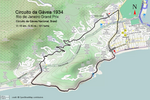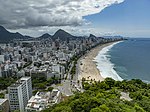Rocinha

Rocinha (Portuguese pronunciation: [ʁɔˈsĩɲɐ], little farm) is the largest favela in Brazil, located in Rio de Janeiro's South Zone between the districts of São Conrado and Gávea. Rocinha is built on a steep hillside overlooking Rio de Janeiro, and is located about one kilometre from a nearby beach. Most of the favela is on a very steep hill, with many trees surrounding it. Around 200,000 people live in Rocinha, making it the most populous favela in Brazil. Although Rocinha is officially categorized as a neighbourhood, many still refer to it as a favela. It developed from a shanty town into an urbanized slum. Today, almost all the houses in Rocinha are made from concrete and brick. Some buildings are three and four storeys tall and almost all houses have basic sanitation, plumbing and electricity. Compared to simple shanty towns or slums, Rocinha has a better developed infrastructure and hundreds of businesses such as banks, medicine stores, bus routes, cable television, including locally based channel TV ROC (TV Rocinha), and, at one time, a McDonald's franchise. These factors help classify Rocinha as a favela bairro, or favela neighborhood.
Excerpt from the Wikipedia article Rocinha (License: CC BY-SA 3.0, Authors, Images).Rocinha
Estrada da Gávea, Rio de Janeiro Gávea
Geographical coordinates (GPS) Address Nearby Places Show on map
Geographical coordinates (GPS)
| Latitude | Longitude |
|---|---|
| N -22.988611111111 ° | E -43.248333333333 ° |
Address
Igreja Nossa Senhora da Boa Viagem
Estrada da Gávea 455
22451-265 Rio de Janeiro, Gávea
Rio de Janeiro, Brazil
Open on Google Maps








